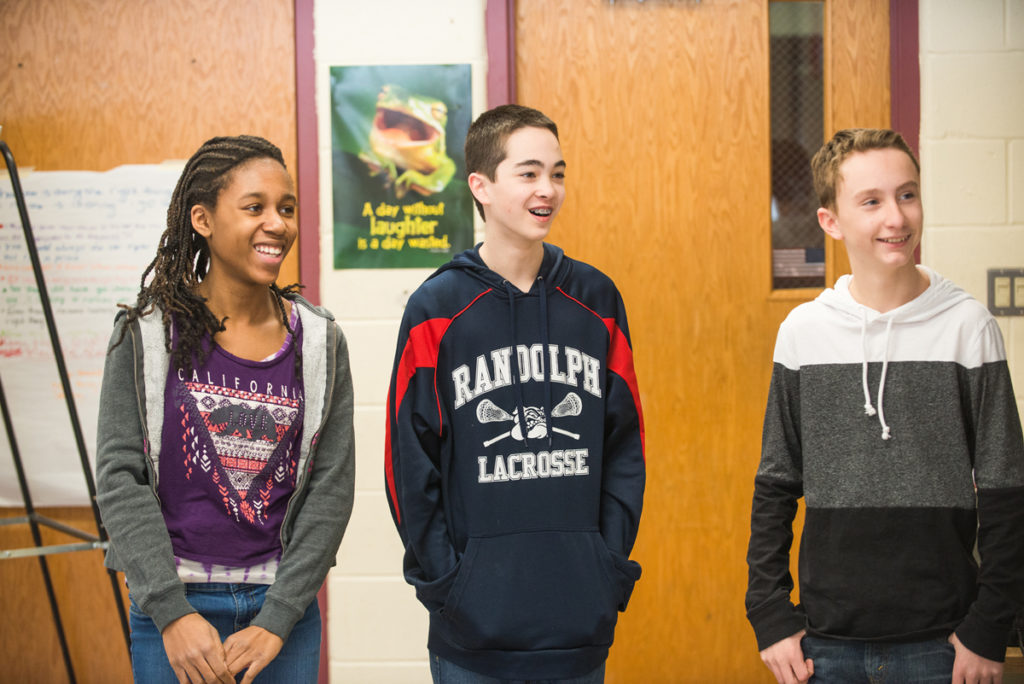
An adapted excerpt from The Power of Our Words for Middle School: Teacher Language That Helps Students Learn.
“You persisted until you figured out a solution to our geometry challenge.”
“I noticed speakers pointing out specific facts from the articles to support their ideas.”
“You respected each other by remembering to speak one at a time today.”
Teacher language—the words, tone, and pace we use when we talk to students—may be the most powerful of all our teaching tools. After all, language permeates nearly every interaction we have with students; we use words to exchange friendly greetings, give instructions, deliver content, and check understanding.
As the examples that open this article show, we can also use language to reinforce students’ efforts and accomplishments by naming exactly which academic and social behaviors they’re doing well. When we use this reinforcing language, we help students build on their successes and develop a sense of themselves as competent learners.
Here’s an overview of this very powerful form of teacher language, along with examples and tips for trying it with the middle schoolers you teach.
By naming exactly which actions are promoting student learning, reinforcing language goes beyond general praise (“Good job,” “Nice work,” “I like that”), which can leave students wondering how to repeat and build on the success our words have recognized. The specific feedback we provide with reinforcing language promotes engaged learning by encouraging students to:
By showing our genuine appreciation of students’ efforts and our respect for them as individuals, reinforcing language also fosters the strong teacher-student relationships that help students feel safe enough to take the risks essential to learning.

Because reinforcing language can powerfully influence student growth, it’s worth using frequently, throughout your time with students, and for any content you’re teaching. Adolescents often dislike being singled out in front of their peers—even for doing well—so you’ll want to reinforce them privately. Doing so will also avoid discouraging other students or fostering competitiveness among them. Of course, if a whole class has shown notable effort or accomplishment, it’s fine to reinforce them as a group.
With so many time pressures facing middle school teachers, it’s easy to fall into the habit of reinforcing only the “best” students—those whose academic performance and behavior are usually exemplary. If you observe closely and objectively over the course of the year, though, you’ll likely see every student you teach making positive efforts and improving their skills, whether in small steps or large leaps.
| Jackson struggles with correct word order when translating sentences from Spanish to English. Today he’s gotten the right order in four out of seven sentences. | (privately) “Jackson, I noticed that you got exactly the right word order in several of your translations today. That shows how your skills are growing!” |
| A class that usually talks over each other has had an animated but respectful whole-group discussion. | “People were patient and waited for their turn before speaking. I also noticed some people thoughtfully adding on to what others said; that helped deepen your discussion.” |
Reinforcing language shifts the focus to students and what they’re doing that’s helping them succeed. Describing students’ actions and behaviors—rather than what we think or how we feel about those actions and behaviors—strengthens their development as self-motivated, responsible learners.
| A student writes an essay in which she supports her argument with factual evidence. | Instead of this: (privately) “Felicity, I’m glad you seem to be understanding how facts and opinions are different!” Try this: (privately) “Felicity, you included lots of specific details to support your position on this question. Using factual information in that way will help make your writing persuasive to readers.” |
| Two students use their own time to research the answer to a question that had stumped the whole class. | Instead of this: (privately) “I really like the way you two took on this extra work.” Try this: (privately) “Althea, Matt, choosing to take on this task all on your own showed great initiative. That kind of effort will help you in all your classes.” |
To promote students’ growth, it’s important to give them precise information about the behaviors that are enabling them to succeed. Precise descriptions help students become aware of what they know, their skills, and their progress.
| Two students are working well together on a collaborative design project. | (privately) “Pradeep, Sierra, it sounds like you’re having a productive discussion. You’re giving each other time to speak and using respectful words when you disagree.” |
| A student finds several ways to practice the speech he’ll be making at an all-school assembly. | (privately) “Wynn, I noticed that you wrote your speech out several times, asked a classmate to listen to you practice, and recorded yourself. Those are efficient ways to help yourself with any kind of memorization.” |
Students need time and practice to master the demanding academic and social skills of the middle school years. To encourage them to persist in working through challenges, we need to recognize their efforts—the imperfect products and almost-there behaviors that are steps along the path to mastery. Using reinforcing language to share our observations about their efforts and partial successes gives them a foundation to build upon as they become increasingly competent.
| Kurt, who continues to struggle with decimal multiplication, asks an insightful question during the class discussion of the weekly quiz. | (privately) “Kurt, the question you asked today showed that you’re thinking hard about how decimal multiplication works. That thoughtfulness will help you develop your skill with decimal problems.” |
| A student who struggled at the start of the year to even begin her in-class work is now completing most of it. | (privately) “Kelsey, I’ve noticed that you’ve been staying focused and getting a lot of your in-class work done by the end of the period. That’s great progress!” |
Following reinforcing feedback with an open-ended question (one that requires more than a yes or no answer) prompts reflection and encourages students to think more deeply. Your questions can help students become more aware of their positive behavior and how it’s helping their learning. Asking questions also encourages students to think about what they might do to advance even further.
| Two students brainstorm ways to illustrate the results of their science experiment. | (privately) “Tamika and Inez, I noticed that you came up with lots of ideas for illustrating your results section. What enabled you two to collaborate so effectively?” |
| Jamal gives an effective presentation. | (privately) “Jamal, your classmates were really focused on you as you presented. What do you think you did to grab everyone’s attention?” |
As you learn to use reinforcing language—or any positive teacher language—you’ll find yourself becoming more aware of the words you use in all your exchanges with students. Gradually, you’ll replace less effective words with skillful reinforcing statements that help middle schoolers move to higher levels of knowledge, confidence, and competency.
As you work on learning new types of teacher language, remember that it’s a process, not an instant transformation. Change and growth take time, so be patient with yourself. The more you use your new words, the more natural they’ll feel to you. Eventually, the new language will flow easily as a true expression of your positive approach to teaching.